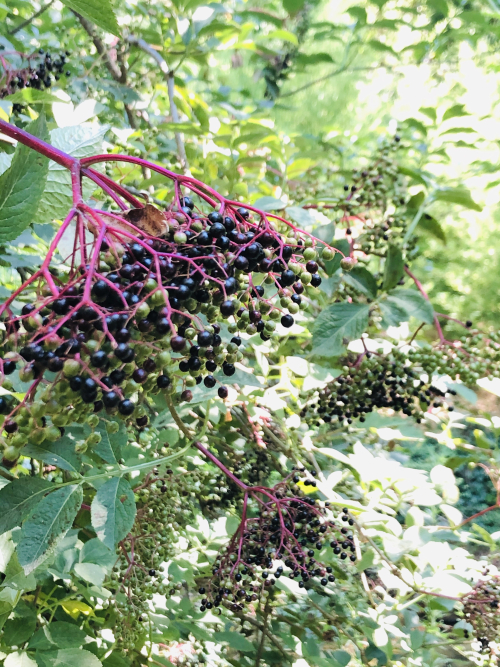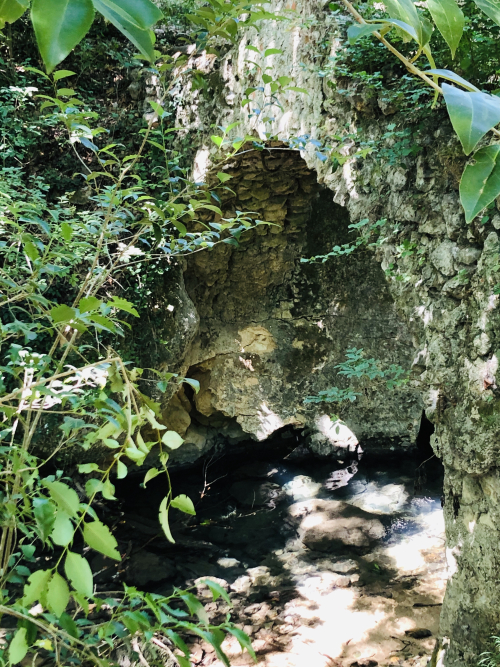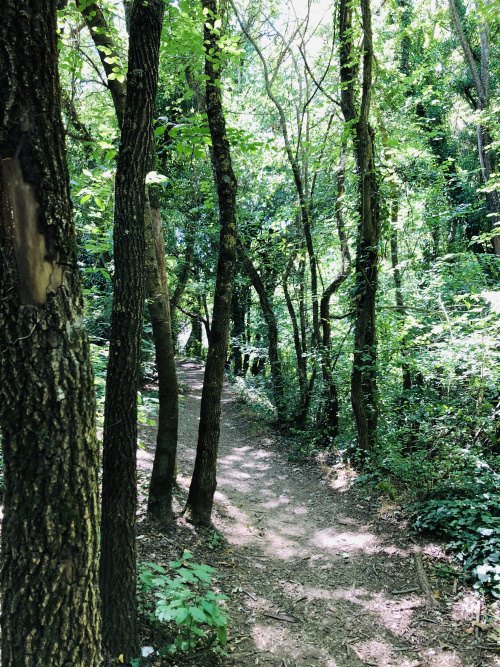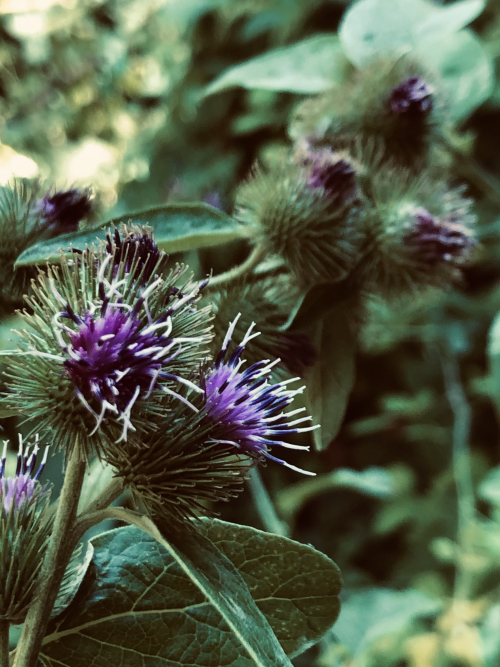The healing grace of living and walking in the countryside.
These photos are from my village, which sits at the base of Saint Baume Mountain. The ancient stone bridges are at the Source du Nans natural park, about a mile from our home. Chelsea and I strolled Gabriel there to put his feet in the ice-cold natural spring, which is said to be the tears of Mary Magdelena (read more below).
My form of physical exercise is walking. I started walking several years ago, but when I went to California, I picked up my pace, trying to do 10,000 steps in an hour and a half; by the end of my stay, I could do 12,000 steps in an hour and a half though I knew when I returned to my home in France the flat land of the Sacramento valley would be replaced by the Provencal foothills. It took me a few days to reach 12,000 steps in an hour and a half. Stopping to take photos, pick flowers, or admire the scenery comes after my walk. Thank you for the comments regarding my post a few days ago. I feel good, and walking in nature has helped me feel this way. I haven't lost weight. As some of you mentioned, I am more toned and am not wearing oversized baby clothes.
We live at the base of a truly enchanted forest with a rich history of spirituality and folklore. This blog post perfectly summarizes what I know to be true.
The following text is from:
Reflections, thoughts, and insights of being a therapist in the city of light and love.
"Sunday, July 22, many gathered in Saint-Maximin la Sainte Baume in southern France to honor Mary Magdalene, as they have for ages. I was unfortunately not one of them this year for several reasons.
For me, July 22 nd has been a special day for a long time because it is the feast day of my favorite saint, Mary Magdalene.
I learned that going to the south of France during July and August is to be avoided unless you want to fight crowds, be stuck in traffic jams, and pay inflated travel costs.
Nevertheless, as the feast day approached, I considered going but decided, in the end, to wait until after the frenzied crowds abated.
Those of you who know me and have been faithful readers of this blog probably already know about my devotion to this saint, as I have written about her in a post last September 2012.
La Sainte Baume has been like a magnet that keeps drawing me back to her mysterious wild beauty and sanctity.
My most recent photos were taken in May 2013, except for the torchlit procession I participated in several years ago.
The procession on the night before, 2121st of July, takes place in Saint-Maximin, encircling the Basilica, where her relic (skull) is displayed.
I first discovered Saint Maximin La Saint Baume back in the early '90s. I was fascinated by the rich tradition and reverence for Mary Magdalen throughout Provence, especially in this somewhat mysterious area.
And yes, this was well before Dan Brown's writings about her, so he had nothing to do with my beliefs and convictions.
Provencal legend has it that Mary Magdalene, after the death and resurrection of Jesus, left the holy land in a boat with several other people who were close to Jesus.
Accompanying her was her brother Lazarus, sister Martha, Joseph of Arimathea, her helper Sarah and several others.
The boat eventually landed at what is now known as Saintes Maries de la Mer, in the swampy part of France known as the Camargue, southwest of Marseille.
On May 24, and 25, there is an annual procession and celebration, which reenacts their debarkation.
All were involved in the Christianization of southern France, especially Mary Magdalene. Lazarus became the first bishop of Marseille, Martha was on to Tarascon, and Joseph of Arimathea went on to found Rocamadour.
After many years of her spreading the teachings and gospel of Christ, Mary Magdalene reportedly retreated to the cave of La Sainte Baume, where she spent her last remaining years. When weak, she was said to be lifted and fed by angels.
Geographically, this sacred site is about 30 kilometers west of Marseille and about 22 kilometers north of the Mediterranean Sea.
The tiny village of La Saint Baume is at the base of the mountain and is made up of the hotellerie, which has served as a place of pilgrimage for eons, attracting not only many of the faithful but forty kings and 15 popes.
Getting there, at least from Marseille, will take you on narrow hairpin roads with steep drop-offs, enough to give anyone slight vertigo.
The scenery is beautiful, and the air is incredibly perfumed with wild thyme, rosemary, and lavender, as would befit the saint who is always pictured with her alabaster jar of perfume.
The landscape can appear relatively arid and mountainous from afar, as it is in most of Provence. Then suddenly, you feel engulfed in a thicket of cooling greenery of the Forêt Dominicale of Sainte Baume.
The Dominican brothers, who have guarded the cave forever, attribute this unusually placed forest to the spirit and energy of Mary Magdalene.
The hôtellerie has been renovated, and I was glad to note that the small chapel in the back, where a lovely tapestry of provocative symbolism hangs next on the list.
A few Dominican brothers and sisters mill around discreetly amongst the many pilgrims who come for retreats and visits to the cave.
For those interested in staying there, the room rates are very reasonable. All the times I was there, the meals were excellent, composed of an entree, main course, cheese, and dessert, including decent red or roses wines from the area at unbeatable prices.
I love staying in the hôtellerie for the sweet energy that abounds here so I can be next to the rather rigorous trails up to the cave.
There are two ways up, one in my mind more challenging to navigate than the other, but both will take you about 45 to 50 minutes of steep hiking upwards.
With all the walking I do here, I consider myself pretty much in shape, but I must admit I sometimes found myself getting breathless towards the summit, stopping briefly before the final onslaught of stairs you must climb to get into the cave.
Both trails are beautifully covered with canopies of hickory, oak, linden, and European yew, some of which are well over a thousand years old.
The Druids considered the European yew, Taxus baccata, indigenous to the area, a tree of death and rebirth.
How fitting that they abundantly line these paths walked by Mary Magdalene, the most faithful of all the apostles to Jesus. Legend also has that it is a pilgrimage for women's fertility.
One of several freshwater streams rushing down the mountain is said to be sourced by Mary Magdalene's tears.
In hiking up, I could feel her heaviness of heart accentuated with each breath and pull of the muscle. The ascent is meditative, inviting us to bring forth our tears and pain for deliverance.
As in our spiritual ascension, our awareness becomes sharper, and our feelings within swirl to the surface. I also wondered about all the other seekers before me who persevered up this same path with faith.
The cave, finally reached with gratitude, welcomes us in her dim, humid coolness. Occasionally drips of water seeping out of the cave walls break the silent contemplation.
Votive candles everywhere flicker in the darkness, their flames beckoning hope and prayerful intercession.
The descent(opposite to what I took to ascend) was more difficult,lt to navigate than the ascent. I passed others already exhausted, trying to climb this wildly savage trail that was difficult to decipher which turn to take next, perhaps mimicking life.
Back at the Hotellerie, one feels a quiet sense of triumph and relief from the rigors of the climb. The sacred moments of being there in her memory still linger with me.
Mary Magdalene leaves a legacy of faithfulness, courage, love, and devotion.
In a time when women were viewed with little merits of leadership, except Jesus, the world's first feminist, Mary left her country of origin for unchartered waters to preach the good news of her beloved rabbi Jesus.
Not surprisingly, She was the last to leave the crucifixion of Christ and the first to discover his resurrection.
She invoked the jealousy of the other apostles, especially Peter, who eventually usurped her power and mission to Christianize lands beyond.
Perhaps through a historical analysis of treasures not yet discovered or validation of what has been uncovered, the truth of her relevant significance can be redeemed.
The early church fathers accorded her as the Apostola Apostolorum or the apostle's apostle, but the Gospel of Mary was never canonically recognized.
In 2016, Pope Francis elevated her feast day of July 22 to be included in the church's liturgical calendar." via A Psychotherapist in Paris Blog.






Leave a Reply